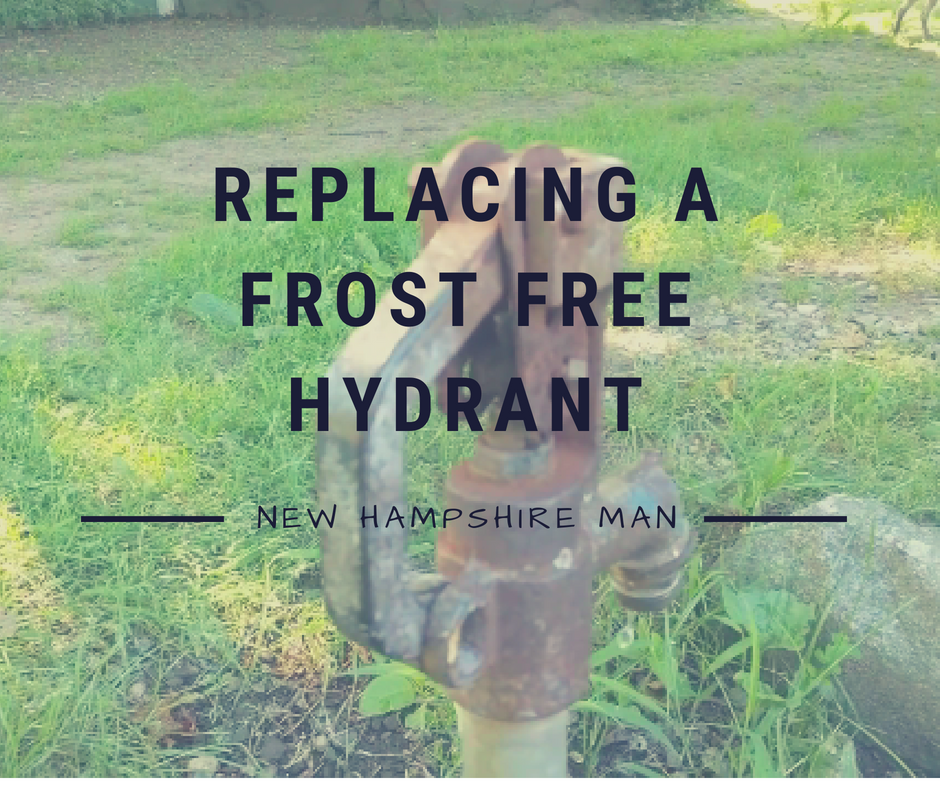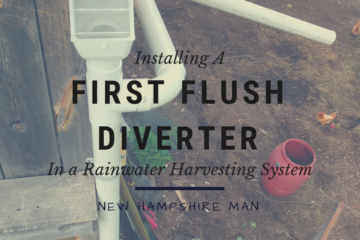If you’ve never owned livestock, it would blow your mind how much water they drink.
And when winter rolls around and you don’t have access to water outside, it would blow your shoulders out hauling it all out there in buckets.
 Enter Frost Free Hydrants
Enter Frost Free Hydrants
Here in New Hampshire, and anywhere else that it freezes, you can’t just trench in a water line anywhere you want. If the system is going to provide water year round, it has to be buried below the frost line.
To get the water from the pressurized line buried several feet underground to an access point at the surface, you’ll need a frost free hydrant. The key feature of this hydrant is that the valve is located below the frost line too, and there’s a little drain hole so that any water in the long pipe bringing water to the surface drains out after each use.
We’re fortunate in that when we purchased our property it already had two hydrants outside, but we’re unfortunate in that one of them started leaking last year. Replacing the hydrant is simple in procedure, but relatively difficult in task due to the amount of digging required, particularly since I don’t have easy access to machinery. For anyone interested in the process to replace a frost free hydrant, I made a video of the process.
But first, a few important lessons learned.
Understanding Systems
If you’re anything like me, you can’t just walk past a dripping water fixture without some serious remorse for such an atrocity as wasting our most precious resource on earth. It took upwards of a year for me to build the courage to start digging out a four foot hole that would be required to replace the hydrant, so while building that courage I would turn the valve off in the house that fed the outside water line.
I want to use that to encourage you to learn all the systems in your domicile. Whether you rent or own, you should have a good idea on where all the water valves are to isolate systems, where each breaker panel is and what each breaker services. Breakers are customarily labeled, frequently incorrectly, but valves are rarely labeled.
My recommendation to you is to verify the labeling on each breaker, and to use that as an opportunity to teach your family too. Start a cell phone call with your spouse and have them verify that power goes out as expected with each breaker flip, and then switch roles so they get accustomed to flipping breakers too.
Consider labeling valves, too, if, after tracing each line it becomes to confusing understanding which line is which. A wire tags like this one can be used on valves, or a sharpy, or any other system that works well for you. Whatever system you use, it’s best that it be understandable to anyone in the event of an emergency.
The Courage to Fix
I mentioned that it took me about a year to build up the courage to dig that hole, right?
You can probably relate. There are those ‘oh man’ projects where some short cuts can serve as a bandaid to the problem, but you really just need to dig in and fix it.
My daughter was the impetus for me to fix this hydrant. The handle was dripping, I was complaining and she was like, let’s fix it, Dad. Ok. Here we go. Grab a shovel.
The best part about that is that we turned this daunting task into a bonding opportunity. It didn’t take long for the project slow down, because she wanted to play, and I wanted to dig, but I realized the need to chill, so while she was helping me, we just had fun. After she went to bed I got busy.
Hat tip to my daughter, and I’m going to try to remember this for the next daunting project to see if we can work on it together.
Is it worth mentioning the SKILLS this kid is developing by helping me work on projects like this?
Crying Once
The last big lesson I want to share with you on this is that it is almost always true that you get what you pay for. I purposely and voluntarily and proudly paid twice as much for this hydrant as I could have, because I don’t want to dig it out again, for a long time.
Long ago, I remember seeing these frost free hydrants in Tractor Supply. I checked their website when I got the beat one out, and the reviews were less than glowing. So I reached out to a homesteading Facebook group (illustrating the value of community) and someone pointed me to a professional plumbing store.
Man, that hydrant is nice!
Let that be a lesson to all of us. The goal is not faster cheaper and lighter. The goal is longevity and quality. Both in what we buy, in what we sell, and in the service we provide. When society tells us to take the shortcut, let us all resist, and instead get the job done once, the right way, with the best likelihood for long-term durability.
It might cost more, but it’ll only cost once.
Onto the show
Ok, so if you actually want to see what a frost free hydrant looks like, please check out the video. Please subscribe to my YouTube Channel to help me keep in touch with you, and make sure you sign up for my email list so we can team up in our journey to freedom and self-reliance.
[sibwp_form id=2]


